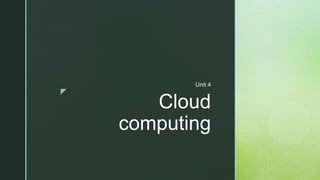Cloud computing.pptx
•Download as PPTX, PDF•
0 likes•4 views
Cloud computing services are divided into three layers: Infrastructure as a Service (IaaS), Platform as a Service (PaaS), and Software as a Service (SaaS). IaaS provides virtualized computing resources. Amazon EC2 is an example of IaaS. PaaS provides development environments for applications. Google AppEngine is an example of PaaS. SaaS provides applications to users. Salesforce.com offers CRM applications using the SaaS model. Clouds can also be public, private, community, or hybrid based on their deployment model.
Report
Share
Report
Share

Recommended
Recommended
More Related Content
Similar to Cloud computing.pptx
Similar to Cloud computing.pptx (20)
Recently uploaded
Recently uploaded (20)
Kodo Millet PPT made by Ghanshyam bairwa college of Agriculture kumher bhara...

Kodo Millet PPT made by Ghanshyam bairwa college of Agriculture kumher bhara...
On National Teacher Day, meet the 2024-25 Kenan Fellows

On National Teacher Day, meet the 2024-25 Kenan Fellows
NO1 Top Black Magic Specialist In Lahore Black magic In Pakistan Kala Ilam Ex...

NO1 Top Black Magic Specialist In Lahore Black magic In Pakistan Kala Ilam Ex...
Unit 3 Emotional Intelligence and Spiritual Intelligence.pdf

Unit 3 Emotional Intelligence and Spiritual Intelligence.pdf
ICT Role in 21st Century Education & its Challenges.pptx

ICT Role in 21st Century Education & its Challenges.pptx
General Principles of Intellectual Property: Concepts of Intellectual Proper...

General Principles of Intellectual Property: Concepts of Intellectual Proper...
ICT role in 21st century education and it's challenges.

ICT role in 21st century education and it's challenges.
Sensory_Experience_and_Emotional_Resonance_in_Gabriel_Okaras_The_Piano_and_Th...

Sensory_Experience_and_Emotional_Resonance_in_Gabriel_Okaras_The_Piano_and_Th...
Interdisciplinary_Insights_Data_Collection_Methods.pptx

Interdisciplinary_Insights_Data_Collection_Methods.pptx
Salient Features of India constitution especially power and functions

Salient Features of India constitution especially power and functions
Food safety_Challenges food safety laboratories_.pdf

Food safety_Challenges food safety laboratories_.pdf
Cloud computing.pptx
- 2. z LAYERS AND TYPES OF CLOUDS Cloud computing services are divided into three classes, according to the abstraction level of the capability provided and the service model of providers, namely: 1. Infrastructure as a Service, 2. Platform as a Service, and Software as a Service
- 3. z Infrastructure as a Service A cloud infrastructure enables on-demand provisioning of servers running several choices of operating systems and a customized software stack. Infrastructure services are considered as the bottom layer of cloud computing systems. Offering virtualized resources (computation, storage, and communication) on demand is known as Infrastructure as a Service (IaaS).
- 4. One of the best examples is Amazon Web Services mainly offers IaaS, which in the case of its EC2 service means offering VMs with a software stack that can be customized similar to how an ordinary physical server would be customized.
- 6. z Platform as a Service A cloud platform offers an environment on which developers create and deploy applications and do not necessarily need to know how many processors or how much memory that applications will be using. In addition, multiple program- ming models and specialized services (e.g., data access, authentication, and payments) are offered as building blocks to new applications.
- 7. Google AppEngine, an example of Platform as a Service, offers a scalable environment for developing and hosting Web applications, which should be written in specific programming languages such as Python or Java, and use the services’ own proprietary structured object data store.
- 8. z Software as a Service Traditional desktop applications such as word processing and spreadsheet can now be accessed as a service in the Web. This model of delivering applications, known as Software as a Service (SaaS), alleviates the burden of software maintenance for customers and simplifies development and testing for providers. Salesforce.com, which relies on the SaaS model, offers business productivity applications (CRM) that reside completely on their servers, allowing customers to customize and access applications on demand.
- 10. z Deployment Models Although cloud computing has emerged mainly from the appearance of public computing utilities, other deployment models, with variations in physical location and distribution, have been adopted. In this sense, regardless of its service class, a cloud can be classified as public, private, community, or hybrid based on model of deployment as shown figure below. Public cloud : Public cloud as a “cloud made available in a pay-asyou-go manner to the general public”.
- 11. Private cloud :Private cloud as “internal data center of a business or other organization, not made available to the general public. ” In most cases, establishing a private cloud means restructuring an existing infrastructure by adding virtualization and cloud-like interfaces. This allows users to interact with the local data center while experiencing the same advantages of public clouds, most notably self-service interface, privileged access to virtual servers, and per-usage metering and billing.
- 12. A community cloud is “shared by several organizations and supports a specific community that has shared concerns (e.g., mission, security requirements, policy, and compliance considerations).” A hybrid cloud takes shape when a private cloud is supplemented with computing capacity from public clouds. The approach of temporarily renting capacity to handle spikes in load is known as “cloud-bursting
- 13. z